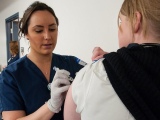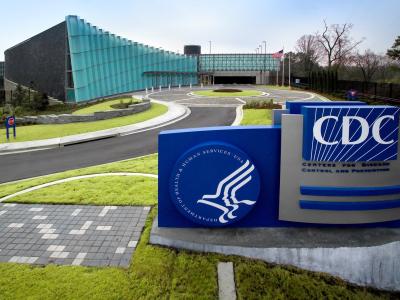Three new studies show high-dose flu vaccines carry a lower risk of myocarditis and cardiovascular events, and flu vaccination offers protection against acute heart failure when administered to hospitalized patients.
Although the protective effects may be small, the first two studies describe high-dose vaccines outperforming standard seasonal influenza vaccines in older adults. Currently, high-dose vaccines are recommended for use in adults 65 years and older, and they contain roughly four times the antigen—the part of the vaccine that produces antibodies against influenza virus—as standard-dose flu vaccines.
Myocarditis risk lower with high-dose vaccine
In the first study, based on findings from the Pragmatic Randomized Trial to Evaluate the Effectiveness of High-Dose Influenza Vaccines (DANFLU-2 trial) in JAMA Network Open, the risk of myocarditis or pericarditis, or inflammation of the cardiac muscle or membrane around it, was lower in people receiving the high-dose inactivated flu vaccine than in those getting a standard-dose vaccine.
Influenza is a known risk factor for developing myocarditis or pericarditis, and this large Danish study looked at the prevalence of the inflammatory condition across three flu seasons, from 2022 to 2025. Of 332,438 participants randomized, 331,143 did not have a history of myocarditis or pericarditis.
The incidence of myocarditis or pericarditis was lower among participants randomized to receive high-dose influenza vaccine compared to standard dose (19 vs 35 events; relative vaccine effectiveness, 45.7%; 95% confidence interval [CI], 2.5% to 70.7%).
Study suggests meaningful clinical benefit
Similarly, a secondary analysis of the same Danish data in JAMA Cardiology finds a small difference in the rate of cardiovascular events that favored the high-dose flu vaccine compared to the standard dose, even among 91,026 participants (27.4%) who had a history of cardiovascular disease.
During the 2022-23 and 2024-25 flu seasons, the incidence of cardiorespiratory hospitalization was 2.25% in the high-dose group, and 2.38% in the standard-dose group. The difference was driven primarily by a lower incidence of cardiovascular hospitalization (1.30% vs 1.40%), the authors said.
Although the observed absolute differences in outcomes may seem small, they could still represent a potentially meaningful clinical benefit.
"Although the observed absolute differences in outcomes may seem small, they could still represent a potentially meaningful clinical benefit," they wrote.
In an editorial on the study, Robert Califf, MD, wrote, "Because of its enormous statistical power and the application of methods that only until recently were technically impracticable, this trial deserves consideration in a broader context than the specific comparison of the effects of 2 vaccine dosages on a specific virus.
"I hope this study points the way toward a future in which we have much more robust evidence to evaluate vaccines and other therapies intended for broad segments of the population."
Heart patients do better with vaccination
Finally, a study across 164 hospitals in China found that administering the flu vaccine during hospitalization for patients with acute heart failure was tied to a 17% lower risk of all-cause mortality or any hospital readmission over 12 months.
The study, published in The Lancet, provides strong evidence to support in-hospital use of influenza vaccination for patients admitted with acute heart failure, the authors said.
Overall, 7,771 participants were enrolled at 164 hospitals in each winter season between December 2021, and February 2024, with 3,570 assigned to the flu vaccination group and 4,201 to the usual-care (control) group. Among those who were vaccinated, 88.1% received quadrivalent (four-strain) forms of the vaccine.
In the primary analysis, 1,378 (41.2%) of 3,342 patients in the vaccination group and 1,843 (47.0%) of 3,919 patients in the usual-care group experienced the composite end point of all-cause mortality or hospital readmission, which corresponded to an unadjusted odds ratio [OR] of 0.83 (95% CI, 0.72 to 0.97).
"This translates to a number needed to vaccinate at the participating hospitals of 27 (95% CI 14–500) to prevent one death or hospital readmission," the authors wrote. "The number of patients with at least one serious adverse event was significantly lower in the vaccination group compared with the usual care group."
In a commentary on the study, Ankeet Bhatt, MD, MBA, of Kaiser Permanente and Stanford University, and Orly Vardeny, PharmD, of the University of Minnesota, write, "The study is an impressive demonstration of implementation science across a wide geographical distribution, including a large number of hospitals over three influenza seasons—the investigators should be commended on their approach and the rigour of this work."
"The observed effect on all-cause death and all-cause hospitalisation is noteworthy."


















